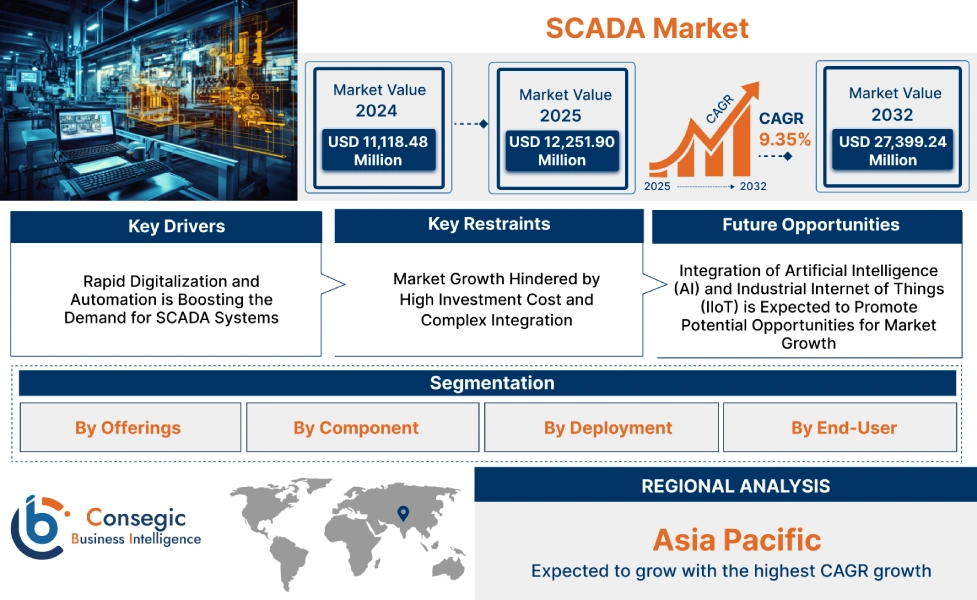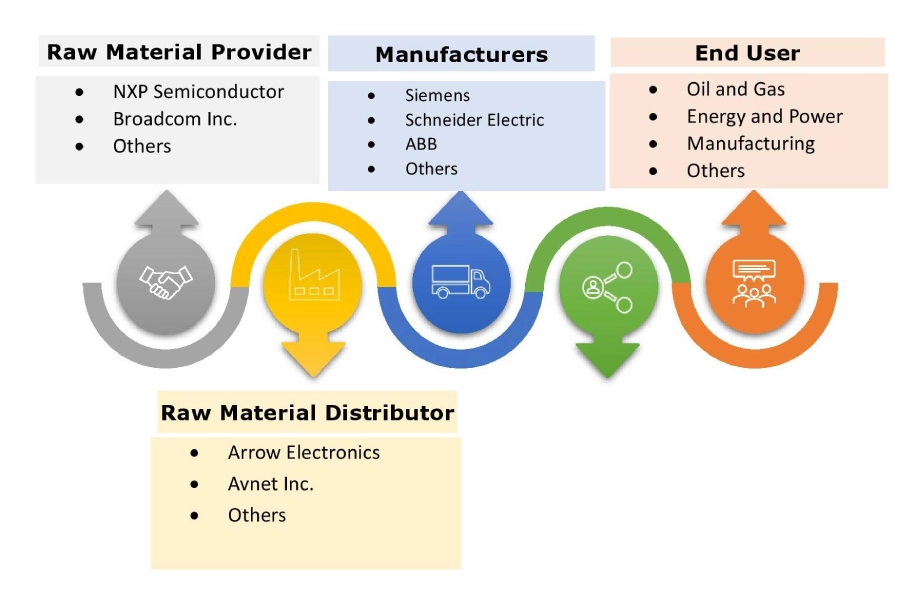SCADA Market Size:
SCADA Market size is estimated to reach over USD 27,399.24 Million by 2032 from a value of USD 11,118.48 Million in 2024 and is projected to grow by USD 12,251.90 Million in 2025, growing at a CAGR of 9.35% from 2025 to 2032.
SCADA Market Scope & Overview:
SCADA refers to supervisory control and data acquisition, designed to monitor and control industrial processes and infrastructure. The key components include hardware that has the ability to collect real-time data from sensors, controllers, and other devices. Also, the device is mainly used to operate complex processes from a centralized location and control equipment remotely. Additionally, the key advantages of integrating the system with the process include enhanced operational control, improved safety, remote control, better decision-making, networked data communication, and trend monitoring, which in turn is boosting the SCADA market growth. Further, the ability to monitor and efficiently manage operations by providing alarms for uncertainty and ensuring smooth automation of systems is driving the SCADA market demand. Furthermore, the system is majorly deployed in industries such as automotive, manufacturing, telecommunications, transportation, and others is boosting the SCADA industry.
How is AI Impacting the SCADA Market?
AI is significantly transforming the market by enhancing its capabilities for smarter, faster, and more autonomous industrial operations. Additionally, AI-powered systems improve real-time data analysis, irregularity detection, and predictive maintenance, leading to increased efficiency, reduced downtime, and improved safety. Also, AI helps to optimize energy consumption, reduce waste, and improve overall operational efficiency in various industries. Further, AI automates tasks and decision-making processes in the systems is driving the integration of AI into the SCADA systems.
SCADA Market Insights:
SCADA Market Dynamics - (DRO) :
Key Drivers:
Rapid Digitalization and Automation is Boosting the Demand for SCADA Systems
The rising adoption of digitalization and automation across various industries, such as manufacturing, oil and gas, and others to improve productivity and reduce costs, is driving the SCADA market demand. Additionally, the Industry 4.0 initiatives leverage supervisory control and data acquisition for real-time monitoring and control of various systems is fueling the SCADA market growth. Further, governments across the globe are promoting industrial automation, which in turn is propelling the need for the implementation of supervisory control and data acquisition systems.
- For instance, in February 2025, Mitsubishi Electric Iconics Digital Solutions, Inc. launched Genesis, which is an advanced supervisory control and data acquisitionautomation and digitalization platform. The platform is designed to cater the evolving need of industrial automation applications.
Therefore, the rapid digitalization and automation across sectors is driving the need for systems, in turn, proliferating the growth of the market.
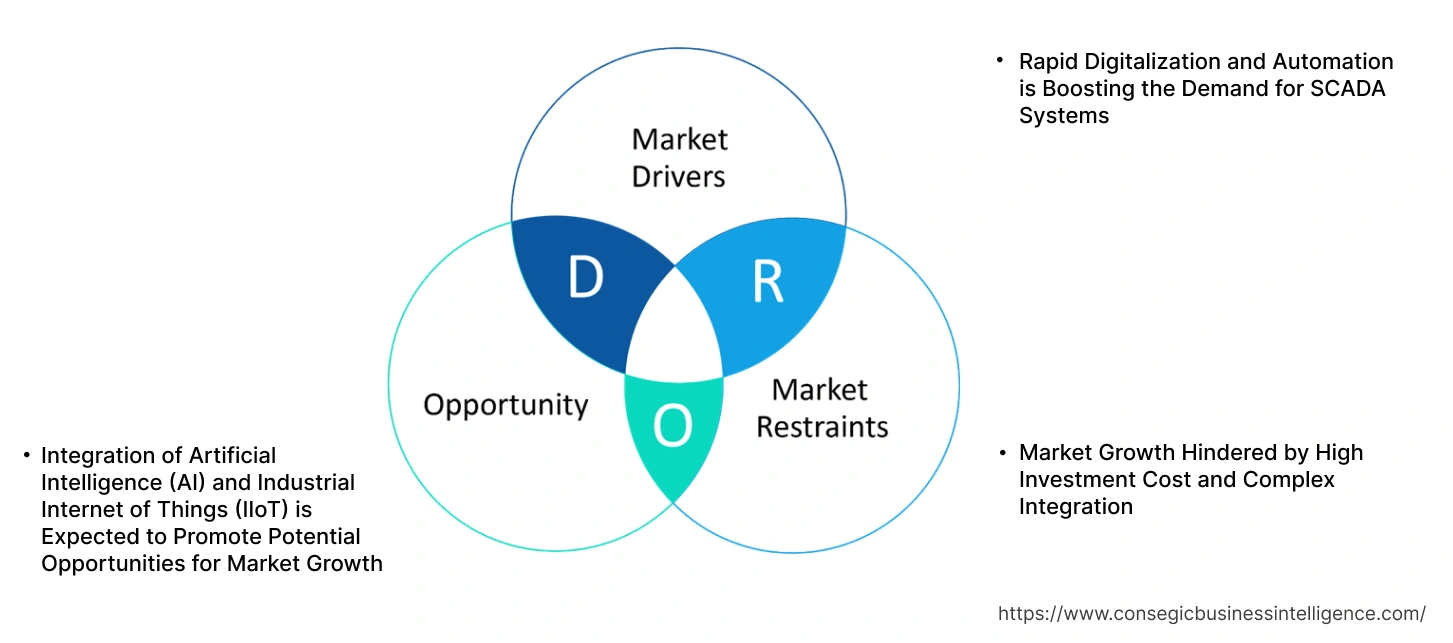
Key Restraints :
Market Growth Hindered by High Investment Cost and Complex Integration
The system encompasses various hardware components like programmable logic controllers (PLCs), remote terminal units (RTUs), sensors, and others, which directly impact the initial investment is hindering the SCADA market expansion. Also, the integration of the system with existing infrastructure and equipment adds to the initial expense. Additionally, supervisory control and data acquisition systems require regular maintenance such as software updates, hardware replacements, and others to ensure smooth operation, which in turn hinders the market progress.
Therefore, the high costs of installation, maintenance, and complex integration utilized in the manufacturing of the system are restraining the SCADA market expansion.
Future Opportunities :
Integration of Artificial Intelligence (AI) and Industrial Internet of Things (IIoT) is Expected to Promote Potential Opportunities for Market Growth
The integration of AI and the IIoT is leading to more intelligent, efficient, and reliable industrial operations, which in turn is paving the way for SCADA market opportunities. Additionally, AI has the ability to analyze large amounts of data from sensors and devices which in turn helps to identify patterns, issues, and optimize system performance, in turn driving the market progress. Further, AI enables real-time monitoring of processes, allowing for immediate modifications and control.
- For instance, in June 2024, AVEVA launched InTouch Unlimited which is an HMI/SCADA software embedded with AI and ML analytics capabilities. It enables users with the ability to collect and unlock data sourced at the edge, with data security.
Hence, the rising integration of AI and the IIoT is anticipated to increase the utilization of systems, in turn promoting prospects for SCADA market opportunities during the forecast period.
SCADA Market Segmental Analysis :
By Offerings:
Based on the offerings, the market is segmented into hardware, software, and services.
Trends in the Offerings:
- The increased cybersecurity measures, as well as integration with IoT and AI, are driving the need for the hardware segment, which in turn is boosting the SCADA market trends.
- The rising adoption of cloud-based SCADA solutions, which allow remote access and data analysis, is driving the need for the software segment, which in turn is boosting the SCADA market trends.
Hardware accounted for the largest revenue share of 57.83% in the year 2024.
- The hardware segment encompasses sensors and actuators, remote terminal units (RTUs), programmable logic controllers (PLCs), and others.
- The hardware components play a critical role in collecting, processing, and transmitting data, as well as controlling industrial processes.
- Additionally, the rising need for real-time data acquisition, process control, and system monitoring is driving the SCADA market share.
- Further, the increasing adoption of automated technologies and the need for smart, digitized production processes are driving the need for the hardware segment, which in turn is fueling the SCADA market share.
- For instance, Schneider Electric offers hardware required for the smooth function of the system, which includes PLC and PAC, among others, catering to the rising needs for industrial automation.
- Thus, as per the SCADA market analysis, the increasing adoption of automated technologies is driving the market progress.
Software is anticipated to register the fastest CAGR during the forecast period.
- The software segment is a key component in monitoring and controlling industrial processes by enabling users to monitor real-time data, manage alarms, and control equipment, among others.
- Additionally, the software segment offers numerous advantages, including enhanced operational efficiency, improved safety, and reduced costs in turn boosts the SCADA market size.
- Further, the shift towards smart factories and Industry 4.0 initiatives is driving the adoption of the software segment, which in turn boosts the SCADA market size.
- Therefore, as per the market analysis, the shift towards smart factories and Industry 4.0 initiatives is anticipated to boost the market during the forecast period.
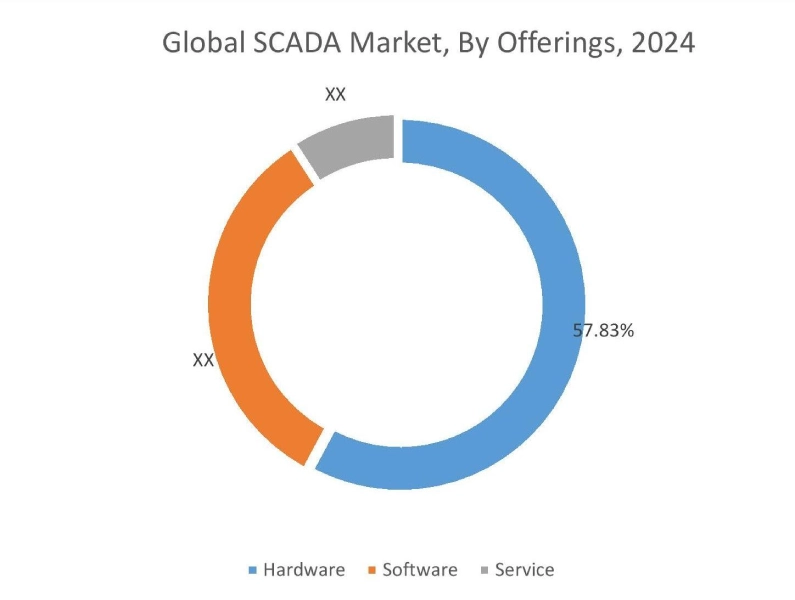
By Component:
Based on the component, the market is segmented into programmable logic controllers (PLC), human machine interfaces (HMI), remote terminal units (RTU), communication systems, and others.
Trends in the Component:
- The trend towards rapid advancement in RTUs to support edge computing, to enable real-time data processing, reduce latency, and others in various applications.
- The trend towards rising adoption of wireless communication technologies, such as 5G, to provide faster and more reliable data transmission in remote and challenging environments, is driving the need for communication systems.
Programmable Logic Controllers (PLC) accounted for the largest revenue share in the year 2024.
- PLCs are essentially specialized computers used to automate manufacturing processes at the machine or process level.
- Also, the PLC system provides real-time feedback as well as offers high flexibility and reliability in automation is boosting the market adoption.
- Further, the adoption of smart manufacturing and increased productivity in modern industries is boosting the need for PLCs.
- In June 2023, WEG launched PLC500MC for the motion controller and PLC500ED for the edge device. The product portfolio is designed to provide advanced control capabilities for robots and others. Also, the edge device enables high-complexity operations.
- Thus, as per the SCADA market analysis, the adoption of smart manufacturing is driving the need for PLCs, in turn fueling the market trends.
Human Machine Interfaces (HMI) are anticipated to register the fastest CAGR during the forecast period.
- HMI is a technology that allows humans to interact with machines, making easily and control systems in various ways.
- Also, HMI systems help operators identify and address potential safety hazards, minimizing risks and preventing accidents. Additionally, HMIs are user-friendly, enabling operators to easily oversee and manage the system.
- Further, the AI integration with HMI enables operational efficiency by allowing tracking of equipment vibration, temperatures, and other parameters, which in turn is fueling the market progress.
- Therefore, as per the market analysis, the AI integration with HMI is anticipated to boost the market during the forecast period.
By Deployment:
Based on the deployment, the market is segmented into on-premises, cloud-based, and hybrid.
Trends in the Deployment:
- The rising need for customization in operations is boosting the adoption of on-premise deployment of systems.
- The rising need for subscription-based models is boosting the need for cloud-based deployment, which in turn is fueling the market progress.
On-premise accounted for the largest revenue share in the year 2024.
- On-premise deployment encompasses the hardware and software located and managed at the facility or site, offering control and management of the system.
- Additionally, the on-premise deployments are tailored to meet specific operational needs by offering unique configurations and functionalities, which in turn is boosting the adoption of on-premise deployments.
- Further, the rising security concerns and increased customization requirements are boosting the adoption of on-premise deployment, which in turn is driving the market progress.
- Thus, the aforementioned factors are driving the market progress.
Cloud-based is anticipated to register the fastest CAGR during the forecast period.
- Cloud-based systems are deployed on remote servers and accessed via the Internet.
- Additionally, the key advantages of cloud-based deployments include cost savings, scalability, and flexibility, which in turn fuels the market development.
- Further, the cloud deployment eliminates the need for expensive hardware and software licenses, reducing the initial capital expenditure.
- Furthermore, a cloud-based system allows for real-time monitoring and control with an internet connection, in turn improving incident response and reducing the need for on-site presence.
- Therefore, as per the market analysis, the aforementioned advantages are anticipated to boost the market during the forecast period.
By End-User:
Based on the end user, the market is segmented into industrial manufacturing, oil and gas, telecommunication, food and beverages, automotive, transportation, and others.
Trends in the End User:
- The rising adoption of systems by the automotive and transportation sector for enabling vehicle tracking and production monitoring, aiming for efficiency and safety in operations.
- The rising adoption of supervisory data acquisition and control systems in the telecommunication sector is to monitor and manage network performance, which in turn helps to maintain network reliability and performance.
Industrial manufacturing accounted for the largest revenue share in the year 2024 and is anticipated to register the fastest CAGR during the forecast period.
- The increasing need to monitor operations in facilities, as well as the growing demand for automation, is driving the need for supervisory data acquisition and control systems in industrial manufacturing.
- Additionally, the systems provide real-time insights into operations, enabling faster decision-making, improved efficiency, and reduced downtime, driving adoption in industrial manufacturing.
- Further, the rise of Industry 4.0, remote monitoring and control, and the integration of digital technologies like IoT and AI are driving the market adoption in industrial manufacturing.
- For instance, JHC Technology Development Co. deployed KMDA-6920, equipped with a supervisory control and data acquisition system in an Indian smart steel plant designed to provide an efficient and reliable production monitoring platform
- Thus, as per the market analysis, the aforementioned factors are driving the market progress.
SCADA Market Regional Analysis:
The regions covered are North America, Europe, Asia Pacific, Middle East and Africa, and Latin America.
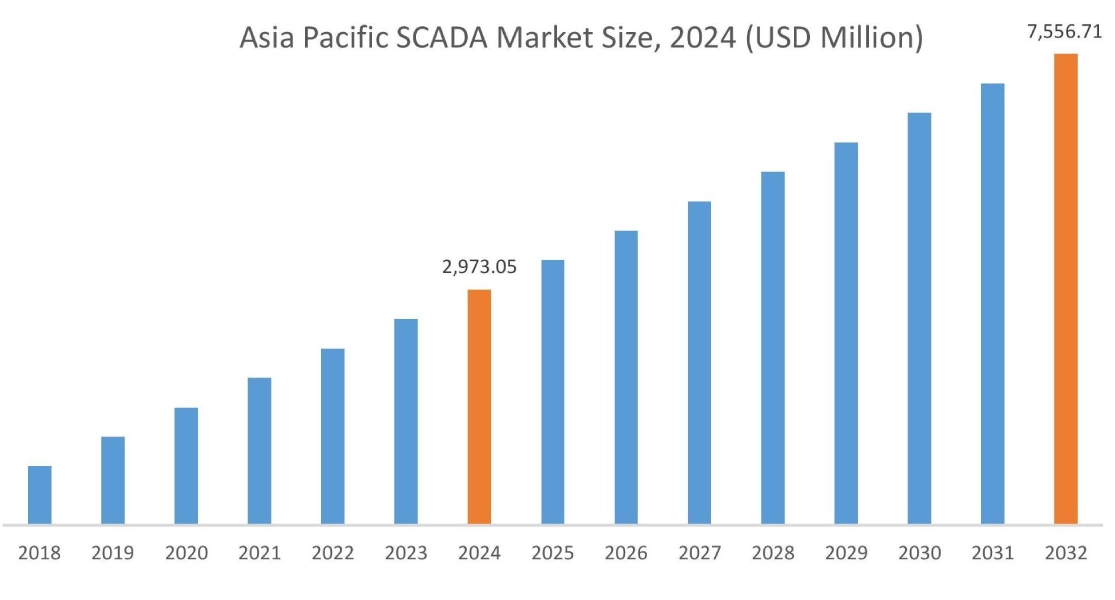
The Asia Pacific region was valued at USD 2,973.05 Million in 2024. Moreover, it is projected to grow by USD 3,284.70 Million in 2025 and reach over USD 7,556.71 Million by 2032. Out of this, China accounted for the maximum revenue share of 30.30%. The market progress is mainly driven by the rising adoption of Industry 4.0 technologies. Furthermore, factors including rapid urbanization and infrastructure development are projected to drive the market growth in the Asia Pacific region during the forecast period.
- For instance, in March 2021, Mitsubishi Electric (Japan) expanded the supervisory control and data acquisitionsoftware product portfolio with the launch of GENESIS64 Basic and GENESIS64 Advanced. The launch aims to cater to rising IoT needs in process automation and monitoring. Also, the software features voice commands and AI smart speakers for monitoring and control.
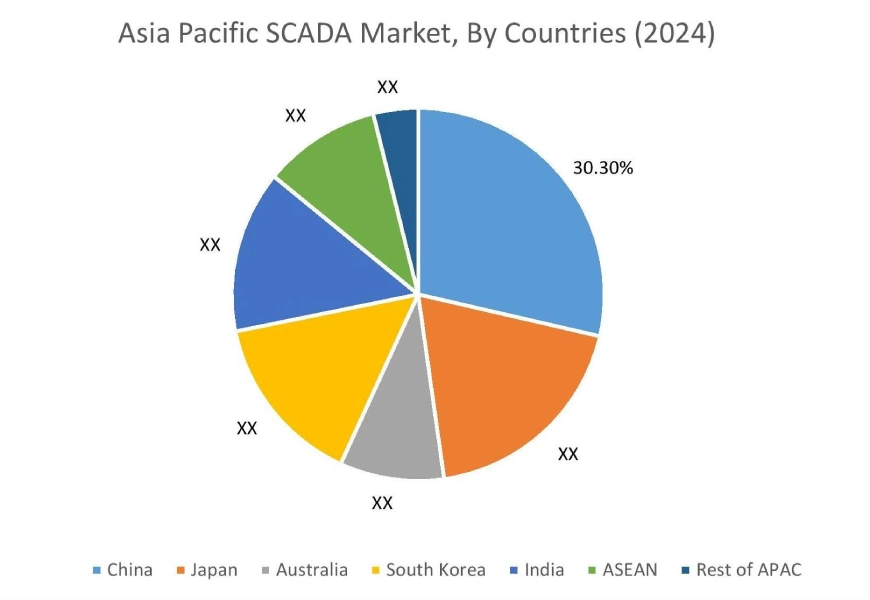
North America is estimated to reach over USD 8,921.19 Million by 2032 from a value of USD 3,591.21 Million in 2024 and is projected to grow by USD 3,959.96 Million in 2025. The North American region's growing focus on the integration of renewable energy sources offers lucrative growth prospects for the market. Additionally, the rising need for smart factories for real-time monitoring, control, and automation of industrial processes is driving the market progress.
- For instance, Inductive Automation (USA) launched Ignition, which is a supervisory control and data acquisition software integrated with HMI and MES into a single solution. It provides real-time control and monitoring, enhanced security, easy expandability, and a wide range of MES modules.
The regional analysis depicts that the increasing investments in intelligent grid systems and the adoption of renewable energy sources are driving the market in Europe. Additionally, the key factor driving the market is the rising demand in industries such as oil and gas, power, water, and manufacturing, as well as government initiatives promoting smart grids are propelling the market adoption in the Middle East and African region. Further, the digital transformation and urbanization are paving the way for the progress of the market in the Latin American region.
Top Key Players & Market Share Insights:
The global SCADA market is highly competitive with major players providing systems to the national and international markets. Key players are adopting several strategies in research and development (R&D), product innovation, and end user launches to hold a strong position in the SCADA industry. Key players in the SCADA market include-
- Siemens(Germany)
- Schneider Electric(France)
- Honeywell International, Inc (United States)
- Mitsubishi Electric (Japan)
- Yokogawa Electric (Japan)
- Inductive Automation (United States)
- OSIsoft (United States)
- KMC Controls (United States)
- ABB(Switzerland)
- Rockwell Automation (United States)
- Emerson Electric (United States)
- GE Digital (United States)
- AVEVA (United Kingdom)
- ICONICS (United States)
- B&R Industrial Automation (Austria)
Recent Industry Developments :
Deployment:
- In March 2025, Yokogawa Australia deployed Yokogawa’s flagship supervisory control and data acquisition system, known as OpreX, designed to help modernize the Melbourne Water Corporation water supply network that serves more than 5 million people.
Mergers & Acquisitions:
- In April 2024, SCADA International acquired Next Consult, aiming to maximize the ROI of investments by integrating end-to-end offerings as well as accelerating grid integration of renewables.
SCADA Market Report Insights :
| Report Attributes | Report Details |
| Study Timeline | 2019-2032 |
| Market Size in 2031 | USD 27,399.24 Million |
| CAGR (2024-2031) | 9.35% |
| By Offerings |
|
| By Component |
|
| By Deployment |
|
| By End-User |
|
| By Region |
|
| Key Players |
|
| North America | U.S. Canada Mexico |
| Europe | U.K. Germany France Spain Italy Russia Benelux Rest of Europe |
| APAC | China South Korea Japan India Australia ASEAN Rest of Asia-Pacific |
| Middle East and Africa | GCC Turkey South Africa Rest of MEA |
| LATAM | Brazil Argentina Chile Rest of LATAM |
| Report Coverage |
|
Key Questions Answered in the Report
How big is the SCADA market? +
The SCADA market size is estimated to reach over USD 27,399.24 Million by 2032 from a value of USD 11,118.48 Million in 2024 and is projected to grow by USD 12,251.90 Million in 2025, growing at a CAGR of 9.35% from 2025 to 2032.
Which segmentation details are covered in the SCADA report? +
The SCADA report includes specific segmentation details for offerings, component, deployment, end user, and regions.
Which is the fastest segment anticipated to impact the market growth? +
In the SCADA market, the software segment is the fastest-growing segment during the forecast period due to the shift towards smart factories and Industry 4.0 initiatives.
What are the key trends in the SCADA market? +
The SCADA market is being shaped by several key trends, including the rising adoption of systems by the automotive and transportation industry for enabling vehicle tracking and production monitoring, aiming for efficiency and safety in operations, as well as the rising adoption of cloud-based SCADA solutions, which allow remote access and data analysis, and others.
Who are the major players in the SCADA market? +
The key participants in the SCADA market Siemens (Germany), Schneider Electric (France), ABB (Switzerland), Rockwell Automation (United States), Emerson Electric (United States), GE Digital (United States), AVEVA (United Kingdom), ICONICS (United States), B&R Industrial Automation (Austria), Honeywell International, Inc (United States), Mitsubishi Electric (Japan), Yokogawa Electric (Japan), Inductive Automation (United States), OSIsoft (United States), KMC Controls (United States) and others.
